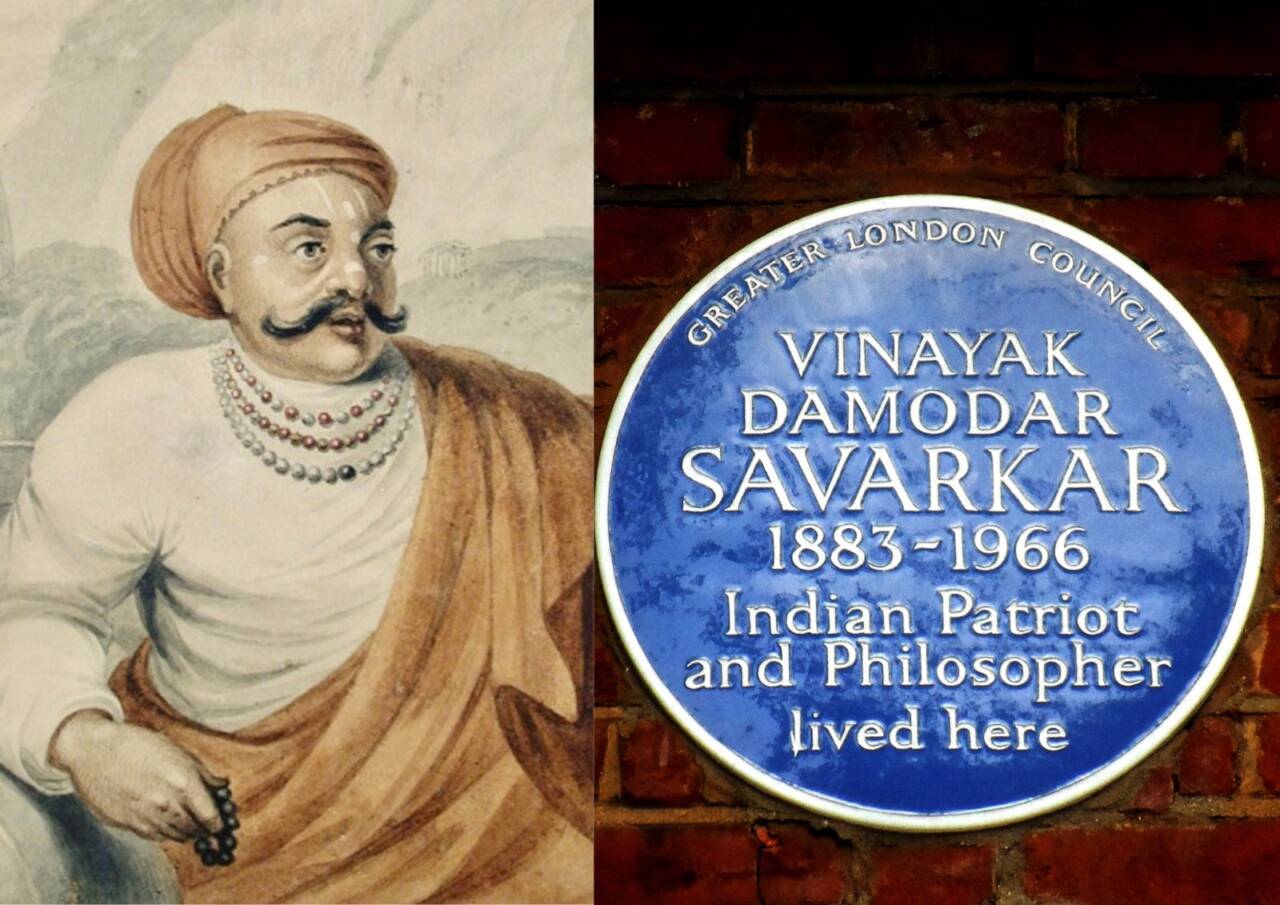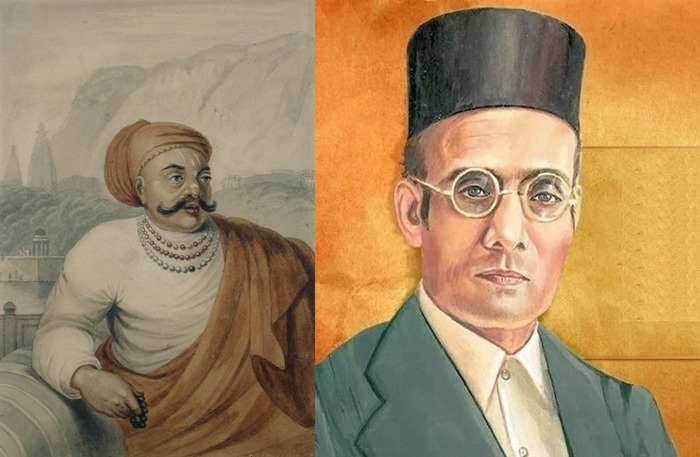Recently some people have raised questions about what Veer Vinayak Damodar Savarkar has written about Scindias also known as Shindes in Marathi and originally known as Sendraks.
This article is an attempt to help those people get their answers substantially and encourage them to read more.
In the majority of his books, Savarkar has openly paid his tributes to the great sons of India, Mahadji Scindia, Jayaji Scindia (Jayappadada), Jankojirao Scindia, Sabaji Scindia and Dattaji Scindia for their patriotic struggle to establish and protect Hindavi Swarajya the precursor to modern Indian Nationalism.
He considered Mahadji Scindia and Nana Fadnavis as the two pillars of Maratha Empire the last Bhartiya empire to rule Bharat, and calls Mahadji Scindia the sword of Bharat. The recurrence of similar views on the aforementioned heroes in all his books manifests the respect Veer Savarkar had for them, while many people call Savarkar their hero, Savarkar himself considered aforementioned Scindia warriors as his heroes.
On Mahadji Scindia Savarkar has heaped praises in his books, for Savarkar he was the man who from Attock to Cuttack protected India from foreign invaders, from the Afghans and the Turks to the British and the Portuguese, so on and so forth. Savarkar had multiple sources being a Marathi to know about these aforementioned heroes, but for 1857 his sources were limited, what he wrote about Scindia in relation to 1857 in his book on the topic is a manifestation of that limitation of sources, because in the same book he also mentions “They (British) realised that the flag of the Mahratta empire waved as far as Attock because men like the Scindia and the Holkar….were ready to give up their lives for Swaraj.”
Now, we know, thanks to the wonderful book of Mr Parag Tope descendant of great warrior and martyr from the war of freedom of 1857, Tatya Tope that how Marathas like Scindias, Peshwas and Newalkars of Jhansi were together against the British and attempts were made by the British to show that they were divided.
Some people want to know about the contemporary sources about Scindia’s help to the freedom fighters they should refer to the testimony of Sitaram Baba alias Mahapurush to British in Mysore and the text A Lady’s Escape From Gwalior and Life In the Fort of Agra During the Mutinies of 1857. By R. M. Coopland Widow of the Rev George William Coopland, M A, Late Fellow of St Catherine’s College, Cambridge, and Chaplain to the Hon. East India Company. Now let us look in detail what Savarkar has written about Scindias.
Savarkar on Valour of Mahadji Scindia
As per Veer Savarkar Mahadji Scindia protected India from European colonial powers may it be British or Portuguese and others, he wrote in his book Hindu Pad Padshahi “Thus foiled in the north by Mahadaji Scindia, the English tried to break up the chain of alliances… the ruin of the last great Hindu Empire… was not yet to be, not at any rate till Mahadji Scindia lived.

By the year 1789, Mahadaji (Scindia) had succeeded in subduing their opponents, defeated and destroyed the Muhammadan clique and humbled the English by fronting them with such a display of power as to make them think discretion the better part of valour. Mahadji (Scindia), the sword of Hindustan, meant on atlantean shoulders to bear the weight of the mightiest of monarchies. Of all the best of statesmen and swordsmen, of Hastings and Wellesley and Cornwallis, that England or France or Holland or Portugal sent out to India to conquer an empire, none could outwit or oppose (Scindia) with any great measure of success.”
Savarkar quotes Maratha ambassador to the court of Nizam, Govind Rao Kale on the valour of Mahadji Scindia “The descendants of Babar seized the kingdom of Hastinapore, of Delhi, and eventually, during the reign of Aurangzeb, we were reduced to such straits that even our religious liberty was denied to us and the wearer of a sacred thread was required to pay a poll-tax and forced to buy and eat impure food.
Now everything that was lost had been regained by us….owing to the astute skill and invincible sword of our Patel—our Mahadaji Shindia. And really everyone who dared to raise his head against us in Hindustan, Mahadaji smashed him down. Indeed, we have achieved what seemed beyond human achievement to consolidate and put it all in order and to enjoy the blessings of sovereignty and empire even as the mighty emperors of old did. The secret of the alchemy that yielded such miraculous results lies in your (Peshwa) hand and that of Mahadaji (Scindia).”
Veer Savarkar’s speech at the 19th session of AKHIL BHARATIYA HINDU MAHASABHA at Karnavati, Ahmedabad, in 1937 Mahadji Shinde (Scindia) held the imbecile Moghal Emperors as prisoners and pensioners in his custody and Hindu supremacy was once more re-established all over the land.
Sometime between 1921-22 Veer Savarkar completed his historic book “Essentials of Hindutva” while still in Andamans. This was later published under the pseudo name ‘A Mahratta’ in that he wrote “Mahadji (Scindia also known as the Great Maratha) steered the nation clear of all rocks and shoals and brought it almost within sight of the coveted shores.
It is this epithet….Hindusthan that, even to this day, owns a loving allegiance of millions of our people from the throne of Nepal to the begging bowl in the street”. In his book Hindu Rashtra Darshan Savarkar wrote, Nana Fadanavis and Mahadji Shinde (Scindia) owned and gloried in their National and Religious oneness as Hindus, and were proud of their national appellation as Hindus!!
Savarkar on Valour of Ranojirao and Jayajirao Scindia
Savarkar wrote on Scindia’s valour against the Portuguese, “Malharrao Holkar, Ranoji Shinde (Scindia) vied with each other in trying to scale the walls of the doomed fort (Bassein). The Portuguese valour that had lionised itself on both the hemispheres could not shake the Marathas from the position they had taken up.
The Portuguese could resist the Marathas no longer, as they kept enfilading and storming the garrison of their foes with such persistence and effect that the long expected end soon came. The Portuguese surrendered and the Maratha banner, triumphant over the tortures of the Hindu faith and the Hindu race, was carried and planted over Bassein, amidst the universal applause of all Maharashtra.”
On Scindia’s victory against Rohilla Pathans who had been established by Aurangzeb Alamgir in the region of Western Uttar Pradesh to crush the Rajputs, Jats and Gujjars Veer Savarkar wrote in his book Hindu Pad Padshahi “Jayajirao Shinde (Scindia), crossed the Jumna and marched against the position the Pathans were holding at Kadarganj.
The Pathans held out doggedly, but the Marathas ultimately won a a splendid victory and routed their forces. Not only that, but they immediately marched out and hemmed in Ahmed Khan, the great leader of the Pathans, who was hastening to help his comrades at Kadarganj, Ahmed Khan entered Farukabad, and the Marathas invested it. The Marathas routed the Moslems, looted their camp and carried away an enormous booty—elephants and horses, camels and banners and baggage.”
Savarkar on the Valour of Dattaji and Jankojirao Scindia
On Scindia’s role in expansion of Swaraj, Veer Savarkar wrote “Dattaji Shinde (Scindia) was ordered to march towards the Punjab and Multan and introduce order and regular government in the newly conquered provinces. He had thence to come down to Kashi, Prayag, where Raghunath Rao was to meet him at the head of another army. Thence the allied Maratha armies were to march on to Bengal, and free the whole province right to the seas by sweeping it clear of the Moslem and of the English who but recently had won a battle at Plassey (1757) and aimed to make themselves the masters thereof.
Accordingly, Dattaji, with his forces, started towards the North. The northern division of the Maratha forces that Dattaji led, reached Delhi at the end of 1758. Thence, as ordered, Dattaji proceeded to settle down the newly conquered provinces of Lahore and Multan. He appointed Sabaji Shinde and Trimbak Bapuji to govern them up to Attock, and garrisoned Sarhind, Lahore, and other important places. ”
On the valour of Dattaji and Jankoji Scindia Veer Savarkar wrote in his book Hindu Pad Padshahi “Dattaji faced Abdally (King of Afghanistan who had invaded India) at Kurukshetra. His personal valour so enthused the Maratha soldiers that they actually forced Abdally to fall back and convinced him that he could not hold out long single-handed against the Shindia (Scindia).
He (Shah of Afghanistan Ahmad Shah Abdali) attempted to cross, and succeeded in crossing, the Jumna and joined Nazibkhan’s forces at Shukratal. Suja too met him there, and Ahmedkhan Bangash and Kutub Shah as well. The Moslem coalition grew more formidable than ever. It was now clear that the single division under Dattaji could not stem the tide. Again his advisers requested Dattaji to fall back : ” Let him go who likes : Dattaji must do the duty of a soldier.”
Such words, from the lips of such a general, could not but have their effect. None left him. On the 10th January 1760, the Marathas marched out to hold the ghats of the Jumna and repel the forces of Abdally that attempted to cross the river.
Dattaji (Scindia) and Jankoji (Scindia), unable to bear the sight of their national banner in danger, both rushed in and engaged in an epic fight. Just then a bullet struck Jankoji, and the gallant youth fell wounded from his horse. Dattaji saw it and, instead of fighting back to a safer position rushed headlong ahead, striking the foes as one possessed and, followed by his faithful follower soon got inextricably mixed with the enemy forces.
At last the inevitable came. Dattaji was hit by a bullet and fell mortally wounded on the ground……Dattaji fell. No soldier in the world defended his national colours more faithfully, or died in defending them more valiantly, than he. The news of the fall of Dattaji and the mean and dastardly insults heaped upon that dying hero reached Maharashtra and set it aflame. The whole people rose like one man and demanded vengeance.
Also Read: https://organiser.org/2021/10/12/18705/bharat/hindustan-must-ever-remain-one-and-indivisible-veer-savarkar-s-landmark-speech-at-karnavati-in-1937/
Conclusion
The author hopes this article will encourage those who, write, tweet, comment and speak without reading about Savarkar his life and his views, about different things to take out time and read what Veer Vinayak Damodar Savarkar has written, not just on Scindias but in general try analysing why did he write it what was the context and they have full freedom to agree or disagree with him but at-least take out time and read his works.
(The writer is the head of Scindia Research Centre, Gwalior)














Comments